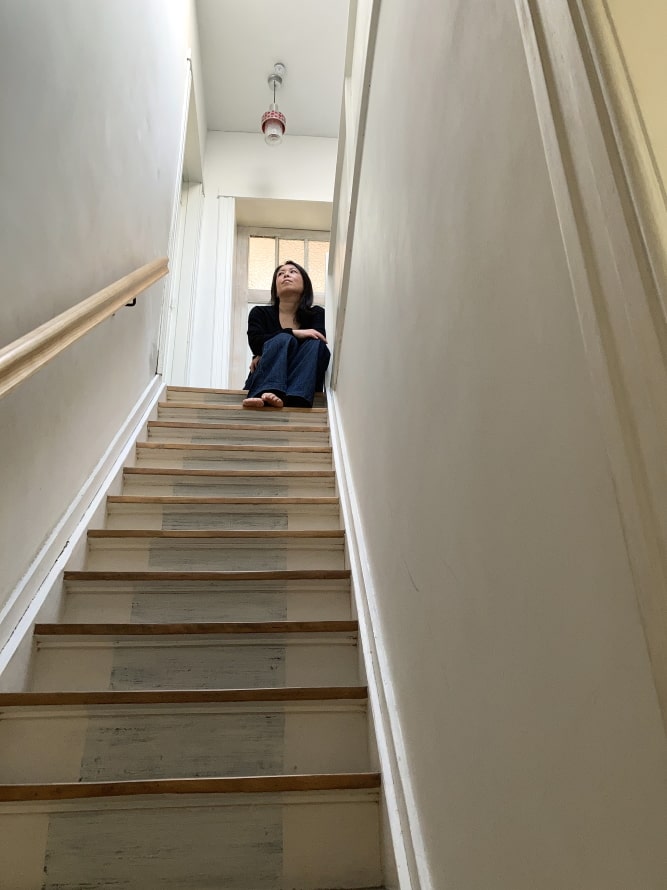Prolog | Persönliches
(Interview in englischer Sprache) Kumi, imagine if the pandemic did not dominate our lives at the moment and we could meet in your home or in your studio. Where do we talk together? Maybe we are sitting at your favorite place? Even the cafés would be open, I feel most comfortable at my own place, especially when I talk about my work. We live outside the city centre of Antwerp, residential area with some nice parks nearby.
Abb. oben: Selbstportrait, © Kumi Oguro

Where do you come from, where were you born when? I was born and grew up in Japan, 100 km north of Tokyo, in a city I don’t particularly feel attached to. Where do you currently live and work? Since 1999 I live in Antwerp, after spending a couple of years each in Tokyo and London. Which stations and people have shaped you? The first important point is when I started living in Tokyo. There I met some friends who opened my eyes for still unknown literature, music, film, art, and life abroad. Without this period, I would not be here now. Which writers do you currently find exciting and which books are on your bookshelf? Recently I was very much impressed by “On Earth We’re Briefly Gorgeous” by Ocean Vuong. Gorgeous!! My part of the bookshelf is filed with a lot of novels. Art books are fewer but they are all precious to me.
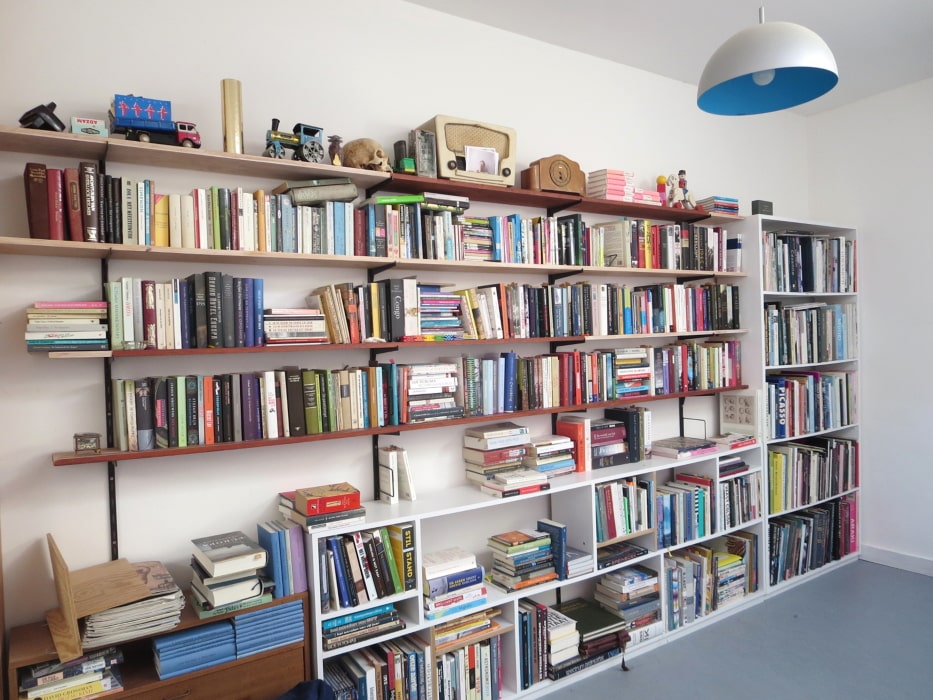
Which books have influenced or shaped you? Most of John Irving, especially his earlier works, and 2 very important photobooks with the works of Francesca Woodman and Anna Gaskell. What are you currently reading and where do you keep the book? “One” by Sarah Crossan for the second time in a row. It’s supposed to be for young adults, but too good to keep it only for them! Still a big pile of books waiting next to my bed, where I mostly read. What music do you listen to and when? BBC Radio 6 Music while I work on the computer or something from 90’s. Right now Daft Punk after the news of their stopping.
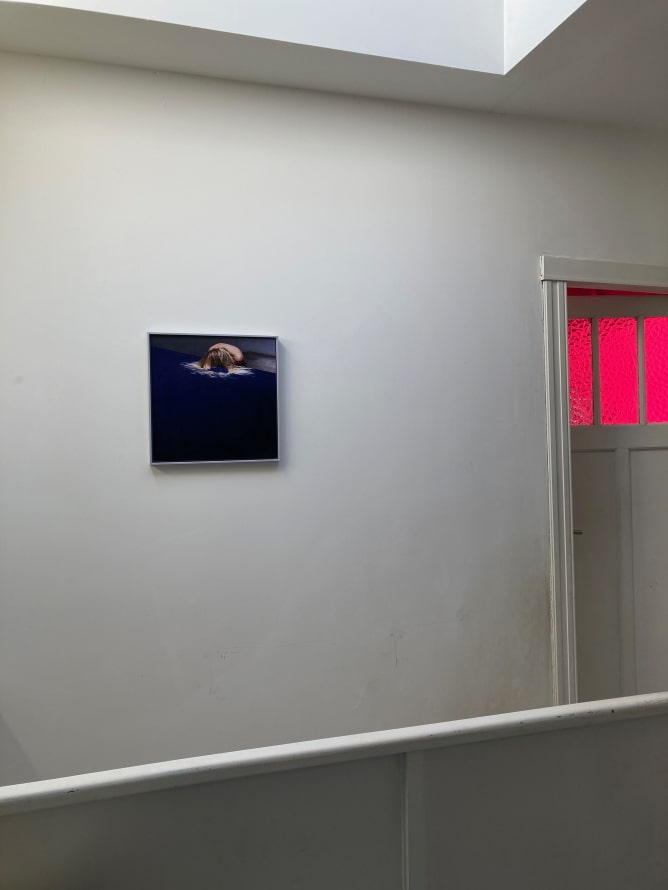
If you would cook something for us, what would it be? Apple pie. What do you like to eat most? Actually what I cook myself. Not that I’m a great cook, but it’s never too greasy or salty. I know what’s in it. I do miss eating out though. What do you think about breakfast? I never skip breakfast. Especially on Sundays and at hotels/B&B I enjoy a lot! What kind of sport or counterbalance to your work do you practice? I’m really not sporty but I do home yoga (youtube) almost daily. Since the first lockdown in Belgium, I appreciate more and more a little walk. I do cycle a lot, out of necessity. What personality trait defines you? Mostly, I’m optimistic, as long as I have a good sleep.
Interview | Künstler + Position
To begin, please tell us your artistic vita in a few sentences.
I started studying photography in London and then in Antwerp. In Antwerp I also followed the master course, Film Studies and Image Culture. I have been exhibiting my photographic works mainly in Europe and Japan.
Briefly explain your current project and the upcoming exhibition.
Right now, I am participating in the group show “THE FEMALE SIDE OF THE MOON” at Galerie Z22 in Berlin. I am also preparing my second photobook that will be called “HESTER”. There will be at least one online exhibition and an online fair (Art The Hague, NL, in anticipation of physical one). For the rest, I just keep creating new works.
What are you most concerned about at the moment; what is on your mind?
Publication of my photobook. Is it going to work out? I have a feeling that it will!

How did you come to art? Why art?
I never had art education when I lived in Japan, except for some lessons in elementary and secondary schools which I never enjoyed. It slowly started when I lived in Tokyo. I was playing around with making collages, writing lyrics for imaginary songs, that kind of stuff. In that period I bought my first camera and started shooting my surroundings, just like most people would do. Not having a basic experience/education in art, photography is something easy to start with (knowing my 0 talent for drawing or painting).
What makes you happy at the moment?
To see a good result after a photo shoot. Having a big pile of fresh vegetables and fruits in our kitchen.
What is currently scaring you?
Not that I’m fearless, nothing concrete. Some of my crazy dreams/nightmares could be a manifestation of what scares me deep inside.
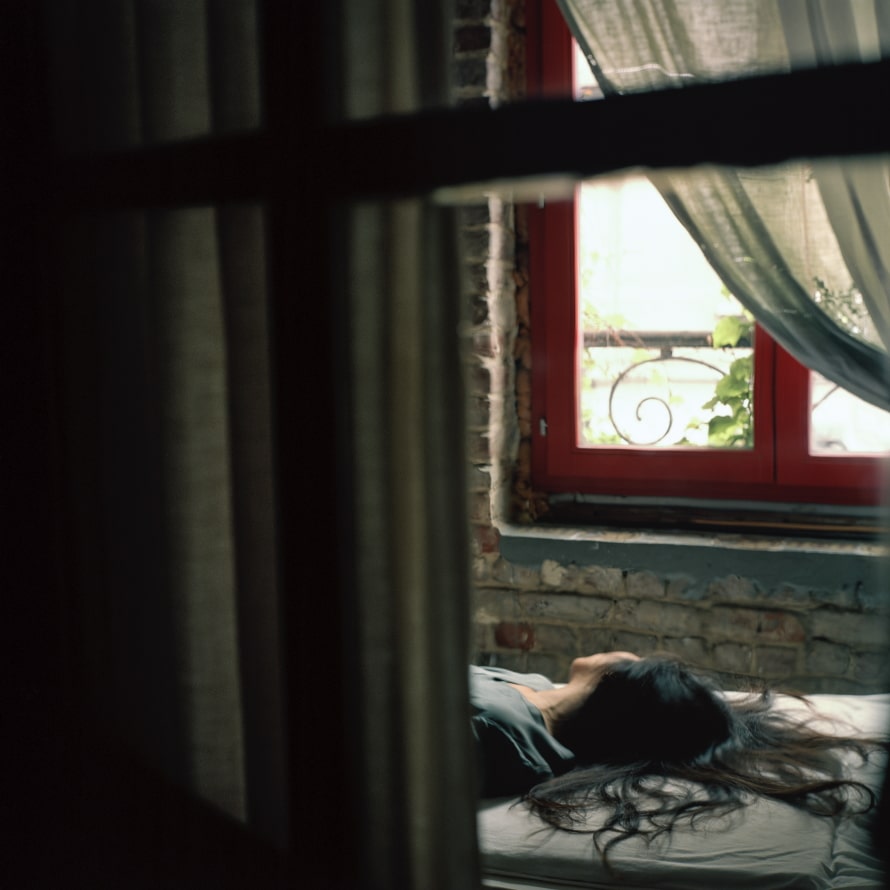
Do you believe that art has a social responsibility? And what do you think it can do?
I don’t know if I could call it “responsibility” but in the current situation, even more than ever, it is really important to realise and show how essential art and culture is for human being.
What makes your art special? What is it about – what are the central themes of your work?
In my photographic work, I create a world just next to our daily reality using mainly female models. Although I would not call my images ‘dream-like’, there is an intangible quality about them, which is similar to the difficulty of describing our waking dreams. There is no story contained within my photographs that has any kind of logical flow.
THE DEED | DAS WERK: Kumi Oguro
Die in Japan geborene und im belgischen Antwerpen lebende und arbeitende Fotografin Kumi Oguro spricht im Rahmen ihres Interviews über die zentrale Botschaft ihres künstlerischen Werks.

Hem, 2018 © Kumi Oguro
Please describe the core theme and the central message of your work.
I create staged photographs, mainly with female models. I would not call them “dream-like”, but there is a similarity with our waking dreams, in the sense that it’s hard to describe what is going on in my images. There is no story or logical flow.
They might evoke your imagination: What has happened? What is going to come? Is this eternity?
I studied film, thought and wrote about the relationship between moving image and still image. It made me, and still makes me think often about the “time” element in my photographs.
Another important element is, what you don’t see in the image, but what is suggested. In many of my images, only a part of the body (hair, legs, arms…) is visible.
Introduce us to the work that, in your view, exemplifies or best embodies the message of your work.
I often choose not to (fully) show the face of the models. Arms, legs or tufts of hair could be much more expressive. No one, including myself, can tell what these female figures, or rather creatures, are doing.

Division, 2014 © Kumi Oguro
What is the aim of your art, your work, what is it supposed to achieve in the viewer?
My first book is called NOISE. In my image, there is something subtly disturbing, but you cannot really grasp what it is, just like a badly tuned radio. When you think you might catch something recognisable, it shifts into noise again, making you more curious.
The publication of the book is back in 2008, followed by a couple of exhibitions with the same title. At certain point, I had enough of that word “noise” and pushed it away from my mind. However, I still find myself keep returning to this idea. It is always there at the core of my work. It might change its shape, but it keeps buzzing in my ear. And that of the viewers probably.
Die Frage nach THE DEED | DAS WERK ist ein ergänzender und separat präsentierter Teil des THE INTERVIEW IN|DEEDS mit Kumi Oguro.

How do you protect yourself from too much inspiration these days?
I do see many things online or offline but I never get “too much” inspiration. I tend to perceive only what attracts me one way or the other.
How much in your works is planned in advance – how much is created intuitively?
It takes a lot of thinking and concentration for the planning of my shoot. I absolutely want to avoid the situation in which I have to say to the models, “Well, what shall I do today?”
My preparation part is still never 100%. For example, a spontaneous movement of a model can create unexpected beauty. I do enjoy what happens on the spot.

What are your (next) goals?
First of all, the publication of my photobook.
As for creations, I do not really work per project or series, just keep going, observing how it evolves. For example, “thanks to” the lockdown, I started making photographs also without models. Curious where this brings me.
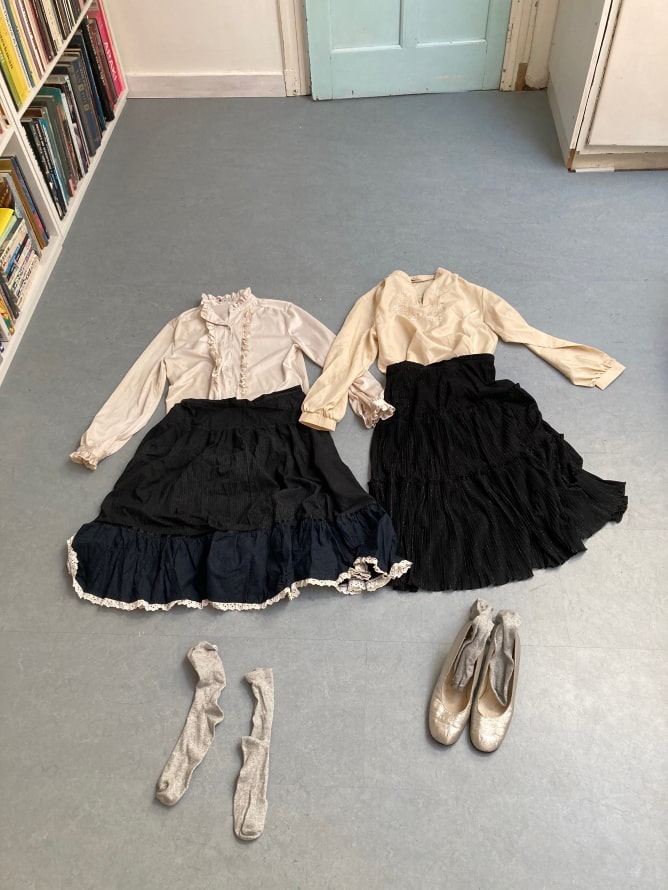
What is your opinion about faith? Do you have principles of faith or is there a motto?
—
Which project would you still like to realize, if lack of time, courage or financial resources would not play a role?
(Solo) exhibitions in all over the world.
What do you consider to be attributes of good art?
By seeing a good piece of art, a mind is filled with a lot of emotions that are difficult to describe in words. More like a silent shock wave. After watching a great film, I prefer to be alone for a while, sinking in the impressions.
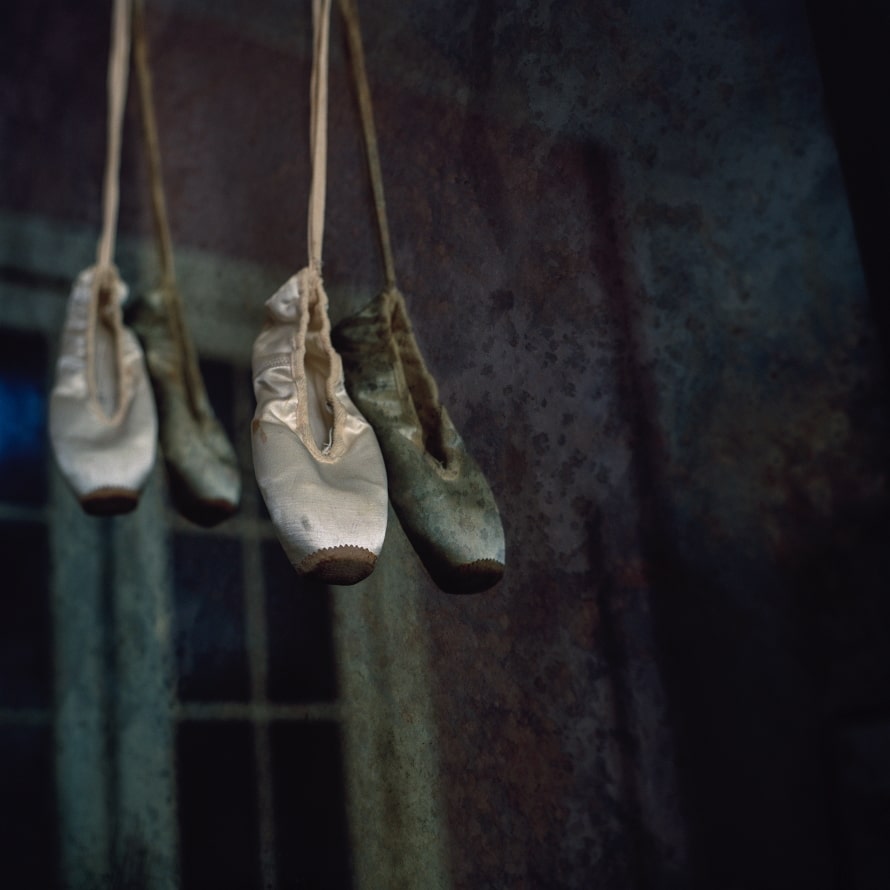
Is one born as an artist? Or is studying art compulsory in your view?
Some artists are, for sure. I don’t think that studying art is compulsory, but everyone needs a certain level of guidance, feedback and stimulation I guess. At least for me.
To whom do you show a new work first?
Sometimes I just put them on my website before showing them to anyone. Then to the galleries I work with.
In the phase of making a selection from some (similar) shots, I sometimes show it to my husband, needing an objective view. Still, it’s me at the end to make the final decision.
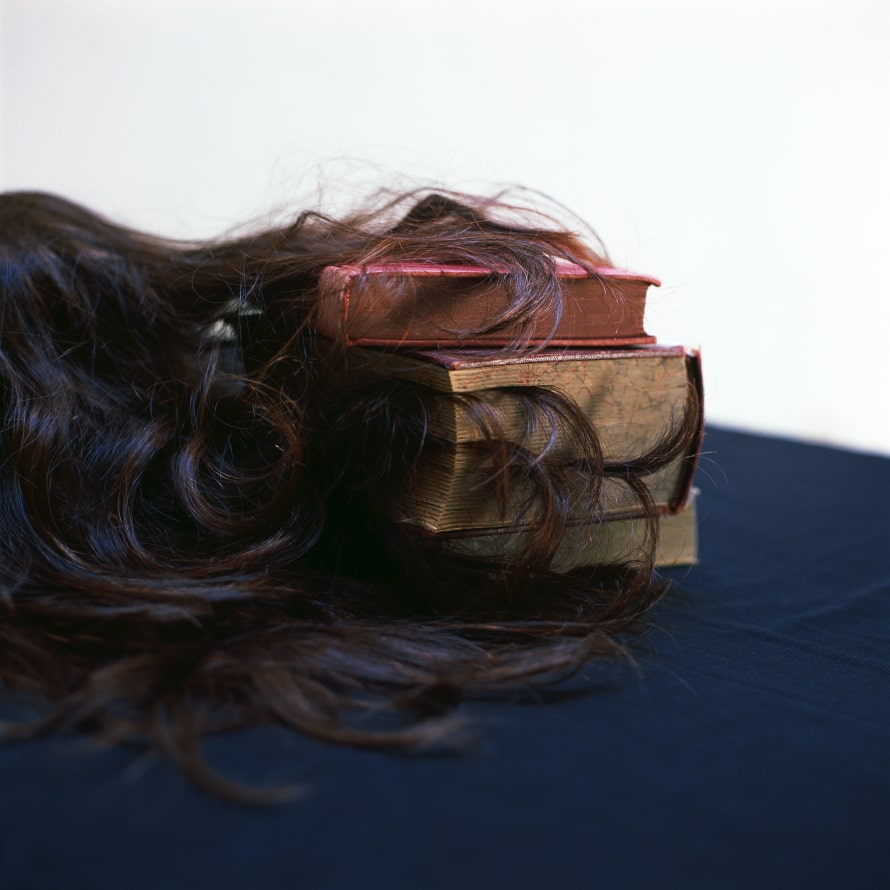
What does the first hour of your day look like?
After my son leaves for school, I try to do as much as possible in the morning.
I spend maximum one hour to work on emails and checking news. Then the second hour (or ideally two) is dedicated to my work-related activities, whatever it is.
In the late afternoon, my energy starts fading away already.
In times of the internet of things, are galleries still necessary? If so, why and what for?
Absolutely. Though I do appreciate the possibilities of online viewing, it’s not comparable with the “live” experience. You see the work and its texture, how different works communicate with each other and with the space. Conversations with the staff can often be an extra value.
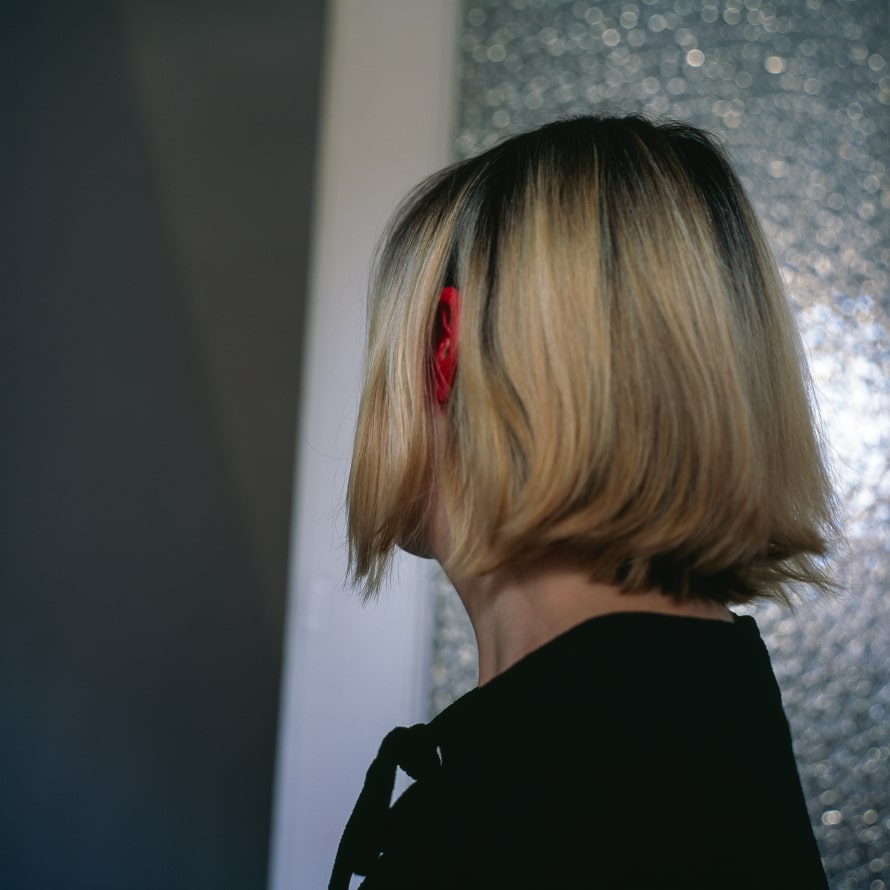
Social media – in your view a blessing or a curse?
I only started Instagram less than a year ago. I might still not use its full potential and I’m not super active. Well, it’s fun.
Epilog | Aktuelles
Die Gruppenausstellung The Female Side of the Moon mit einer Arbeit der Fotografin Kumi Oguro ist hier als 3D Tour virtuell besuchbar. Die Ausstellung war vom 23. Januar bis 27. März 2021 in der Galerie Z22, Zähringerstraße 22, 10707 Berlin-Wilmersdorf zu sehen. Im September 2021 wird die Ausstellung fortgeführt. Mehr Informationen dazu folgen.
In Zeiten von Corona, in denen Reisen, Atelierbesuche und persönliche Kontakte unangebracht oder sogar unmöglich sind, bleibt das schriftliche Interview ein wichtiges Medium, um Künstlerpersönlichkeiten vorzustellen, um ihre Botschaften zu verbreiten und um mit Kunstliebhabern in Kontakt zu bleiben. Die Interviews werden von der Redaktion nicht redigiert oder gekürzt und stets im O-Ton wiedergegeben. Daher nehmen wir auch keine Übersetzung des Interviews in Englische bzw. Deutsche vor, es sei den, diese wird seitens des/der Interviewten eingereicht.


